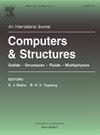Optimal Uniform Strength Design of Frame and Lattice Structures
Abstract
This paper provides a procedure to obtain the uniform strength of frame and lattice structures. Uniform strength condition is achieved by performing the shape optimization of all beam elements of the structure. The beam shape which guarantees uniform strength is analytically deduced from the one-dimensional Timoshenko model. The optimization problem presents itself as the search for the zeros of the objective-functions vector, which is a non-linear system of equations representing the kinematic-congruence and forces balance at every node of the structure. The analytical formulation of the optimization problem allows to construct the objective-functions vector without the use of external structural computation, i.e. not recurring to any Finite Element Analysis to accomplish iterations. This latter feature entails a great advantage in terms of computing time required to perform optimization. The proposed analytical formulation allows to directly insert the uniform strength condition into the objective-functions vector, transforming the optimization into an unconstrained problem. Some examples are shown in which the performance of the optimization procedure is discussed in terms of robustness and rate of computational complexity while increasing the degrees of freedom of the structure. The reliability and the quality of the optimization are verified through Finite Element Analysis.

 求助内容:
求助内容: 应助结果提醒方式:
应助结果提醒方式:


